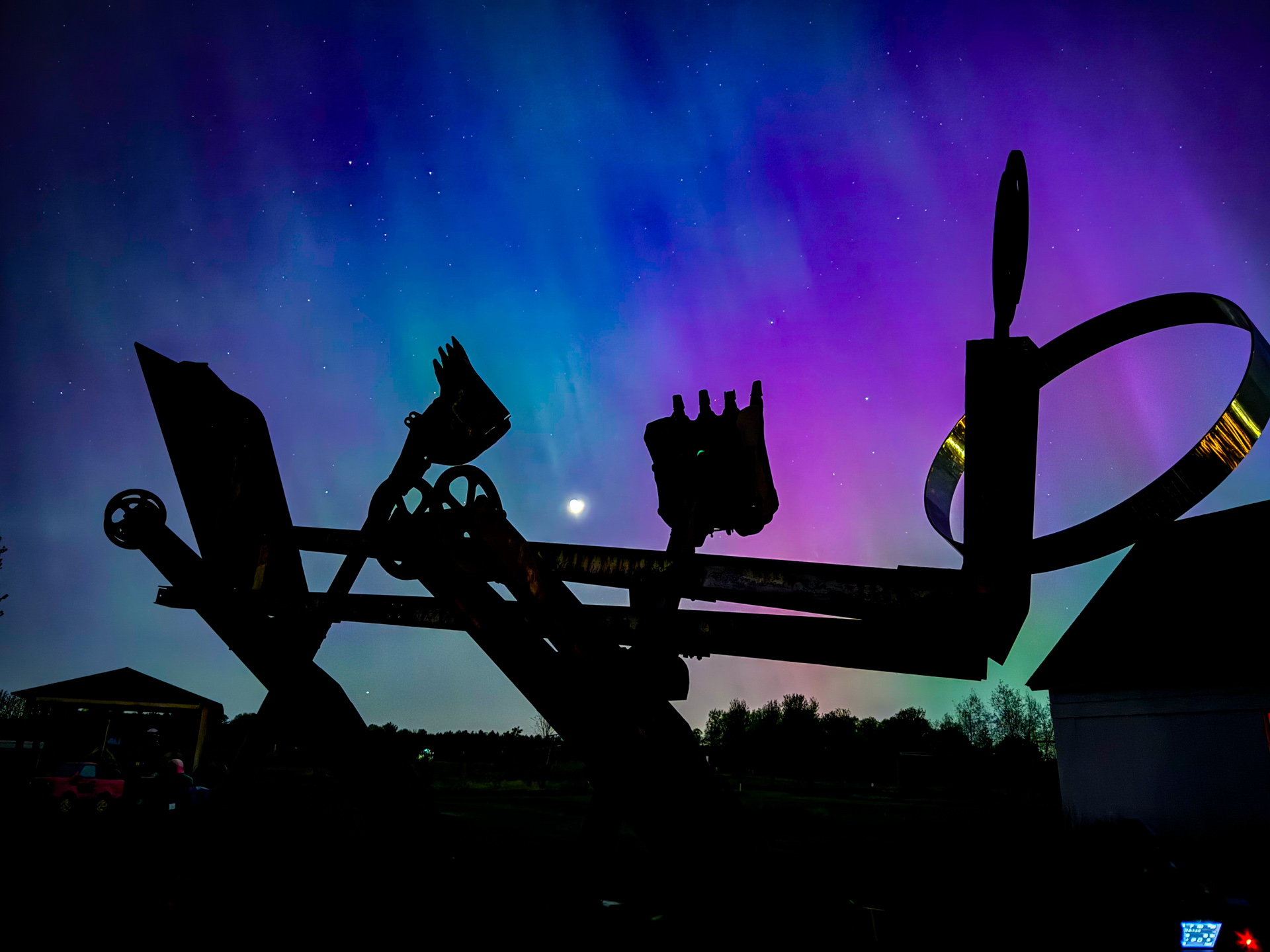
Even if light pollution were not an issue, we’d rarely see the northern lights because our latitude in Minneapolis is outside the normal auroral oval. But last week, Earth experienced a strong geomagnetic storm and we were suddenly in the middle of it! Here was a chance to see aurora without traveling to Alaska or Manitoba! And it was the perfect opportunity to photograph them with my wide-angle lenses, one of which I call my “Milky Way/aurora lens”, a 2-1/2-pound monster for just this purpose! But we needed to get away from the city lights.
There is a sculpture park, Franconia, that Poldi and I have enjoyed and contributed to for many years, and it was less than an hour from home. We arrived before sunset and sought permission to take photos, even after the normal park closing time. As I was scouting for locations and setting up tripods, a trickle of other visitors arrived with the same purpose: to see the predicted northern lights. As twilight faded, the aurora tourists expanded to dozens of vehicles, all of which had headlights that swept across the sculpture park grounds, interfering with my carefully selected compositions.
I have learned not to react to unexpected lighting situations. Oftentimes, they make for interesting photographic results. One of my favorite examples is when I was shooting reflections on a calm alpine lake and a group of partiers arrived and went skinnydipping, breaking up the smooth lake surface. Rather than close the shutter and move on, I kept it open for the duration of my planned exposure. It created a wonderful blend of reflected and scattered light!
My cameras were taking successive exposures of the northern lights which I hoped to assemble into a timelapse, so I just kept the shutters running despite the traffic. I didn’t know how long the aurora conditions would last, but I was prepared to stay all night; we had provisions and sleeping bags in the car– standard preparations for night sky photography. I figured the tourists would get tired and cold and head home by midnight.
Well, I was partly right. The early visitors, especially those with kids, headed home, but they were replaced by a different demographic- young people in their twenties, arriving as couples or in groups to take in the cosmic experience.
It was all good. A beautiful clear night under the stars, watching a crescent moon set and the entrancing curtains of auroral light in a shared experience with others who found it equally fascinating and calming to their souls. We spent time on a blanket, looking up at the radiating lights surrounding us and watching them evolve- faster than clouds, but slower than lava lamps. I listened to my camera shutters clicking away, keeping time with the majestic pace of the flowing lights.
Eventually, we became tired and cold ourselves, and with camera batteries becoming empty, and memory cards becoming full, we took our leave of the park.
Back at home, I could still (barely) see the faint green glow of the sky away from the streetlights. It was late, but I was excited to see what my cameras had captured, and so I made some first rough cuts of aurora videos. They were both exciting and disturbing. Exciting because the cameras and lenses had acquired exposures that showed the beautiful color and structure of the lights. Disturbing because, at the standard video playback rate, they appeared “unnatural” (as if aurora can ever be seen as natural). They flickered and moved too fast. Yes, it is a timelapse, but the idea is to capture the beauty of unseen motion, not to turn it into a wild laser show.
With dawn arriving soon, I gave up and went to bed, wondering how to salvage my timelapse project.
Over the next days, I did several experiments with slowing down the playback rates. This helped reduce the frenetic visual pace, but introduced a different artifact, the jerky motion that occurs when the frame rate becomes too low.
To solve this I needed frames that I did not have (and could not have acquired). My exposures were taken at four second intervals. What I needed were at least four exposures over that interval, instead of just one, but even with my fast aurora lens, I could not get a decent exposure at such a rate.
So I improvised and made a script to take two successive images and compute three “in-betweens”, interpolating them. This isn’t really what the camera would have captured if it could have made those intermediate exposures, but it would visually soften the transition from one picture to the next. It took a lot of compute-time to do this for every pair of images in my sequence, and I made lots of false starts, but a week later, I had them.
With four frames for each four second interval, this is the equivalent of taking one picture per second. When played back at 30 frames per second, this is 30X faster than the experience of watching the aurora in person. It is fast, but not too fast (at least for my visual preferences). The previous rate, without the interpolated frames, was 120X normal speed.
Now with watchable timelapse clips, I assembled them into a short video. I found two candidates for background music and trimmed the video to match. I suggest watching the shorter one first (4 minutes) and if you still haven’t had enough, you can watch the longer, slower-paced version (5 minutes). Keep in mind that this represents 2-1/2 hours of real-time camera work, and I’m only showing you half of what I acquired on that marvelous night!


OMG! So AMAZING! Thank you for posting and sharing your images. Great job!!!! Dawn